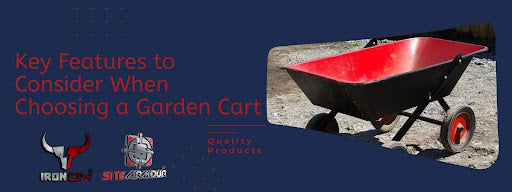
Key Features to Consider When Choosing a Garden Cart
A cart is an invaluable tool for any avid gardener or landscaper. It provides convenience and efficiency in transporting tools, plants, soil, and other materials. With various models and features available, selecting the right garden cart can be overwhelming.
As an avid gardener, I've realized that a reliable garden cart is one of the most essential tools you can own. It saves time and significantly reduces the physical strain of gardening tasks. However, finding the perfect garden cart can be daunting with so many options available. After years of trial and error, I've discovered that selecting the right garden cart boils down to understanding key features matching your needs. Here’s a guide to help you decide and find the perfect cart for your needs.
1. Types of Garden Cart
- Wheelbarrow-Style Carts: These carts have one or two wheels at the front and are ideal for maneuvering through tight spaces. They are great for uneven terrain but can be challenging to balance.
- Two-Wheeled Carts: Offering more stability than wheelbarrows, these carts are easier to handle on flat surfaces. They are often used for heavier loads.
- Four-wheeled carts provide excellent stability and are suitable for transporting large quantities of material over flat or slightly uneven ground. They are often used for bulkier items.
2. Material and Durability
- Steel Carts: Known for their strength and durability, they can handle heavy loads but may be prone to rust. Look for carts with a powder-coated finish to resist corrosion.
- Plastic Carts: Lightweight and resistant to rust and corrosion, plastic carts are easier to maneuver but may not support as much weight as steel carts.
- Wooden Carts: These offer a classic look and are often used for decorative purposes. They may require more maintenance and are less durable than metal or plastic.
3. Load Capacity
Consider how much weight you’ll need to transport. Garden carts have varying load capacities, typically 150 to 1,000 pounds. Ensure the cart you choose can handle your typical load, considering that overloading can cause wear and tear.
4. Wheels
- Size and Type: Larger wheels are better suited for uneven or rough terrain, while smaller wheels are ideal for flat surfaces. Pneumatic (air-filled) wheels provide a smoother ride over rough ground, while solid rubber wheels are low-maintenance and suitable for flat areas.
- Swivel Capability: Some garden carts come with swivel wheels, which enhance maneuverability and ease of turning.
5. Handle Design
- Height Adjustment: If the cart will be used by multiple users of different heights, look for it with adjustable handles.
- Comfort Grip: A padded or ergonomic handle provides better comfort, especially when transporting heavy loads.
6. Dumping Mechanism
For convenience, some garden carts feature a dumping mechanism, allowing you to easily unload materials by tilting the cart. This feature is particularly useful for tasks like spreading mulch or soil.
7. Versatility and Accessories
- Removable Sides: Some carts have removable sides to load and unload bulkier items easily.
- Built-in Tool Holders: Consider carts with built-in holders or compartments for tools and accessories to keep everything organized.
- Canopy: In sunny or rainy conditions, a canopy can protect both you and your materials.
8. Ease of Assembly and Storage
- Assembly: Check if the cart comes pre-assembled or requires assembly. If it needs to be assembled, ensure it comes with clear instructions and all necessary parts.
- Storage: Foldable or collapsible carts are ideal for those with limited storage space.
9. Price and Warranty
Prices can vary widely based on features and materials. Set a budget and compare different models to find the best value. Additionally, check for warranty coverage, which can provide peace of mind and protection against defects or issues.
Based on my opinion, selecting the right garden cart involves evaluating your needs and considering factors like type, material, load capacity, wheel design, and additional features. By assessing these elements, you’ll find a garden cart that enhances your gardening experience, making it more efficient and enjoyable.
